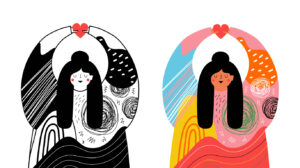Beyond Reflections: A Journey to Balance and Self Discovery
Body image, an intricate tapestry woven from perceptions, emotions, and thoughts about one’s physical self, plays a profound role in human existence. This multifaceted concept encompasses cognitive, perceptual, affective, and behavioural dimensions, shaping individuals’ perceptions and relationships with their bodies. Despite actual appearance, body image misperception is prevalent and linked to various serious health issues. Understanding distortions in healthy cognition and perceptual distortions in clinical conditions is crucial for addressing body image concerns and enhancing well-being. This article aims to explore the importance of cultivating a positive body image, understand the roots of body dissatisfaction.
Definition:
Body image is a multidimensional concept, encompassing cognitive, perceptual, affective, and behavioural aspects. Cognitive components involve thoughts and beliefs about the body, while perceptual components encompass how individuals perceive the size and shape of their bodies. The affective aspect involves feelings about the body, and behavioural components include actions taken in response to body image, such as isolation or engaging in destructive behaviours to alter appearance. Related terms, such as body image distortion, misperception, disturbance, negative body image, altered body image, and body dissatisfaction, are often used interchangeably in the literature.
Body Image and Resilience:
Cultivating a positive body image serves as a resilience booster, providing vital protection against the development of eating disorders. Programs designed to enhance self-esteem, foster positive body image, and promote a balanced approach to nutrition and exercise play a pivotal role in shaping a healthy mindset. Beyond mere satisfaction with physical appearance, a positive body image significantly influences overall well-being, self-acceptance, and the adoption of healthier attitudes and behaviours.
Identifying Causes of Body Dissatisfaction:
To navigate the internal and external influences contributing to body dissatisfaction, it’s crucial to recognize various factors at play. Age, gender, mental health, social environment, and societal expectations all contribute to shaping perceptions. Acknowledging and understanding these influences empower individuals to address and mitigate the risk of developing a negative body image, fostering a healthier relationship with their physical selves.
Social Pressures:
Body image is observable as a social phenomenon influenced by social acceptance. Individuals, particularly adolescents, develop behavioural responses to enhance their social desirability, influenced by societal pressures and weight-related bullying. The pressure to conform to societal ideals contributes significantly to the development of negative body perceptions.
Social Media:
Social media, play a powerful role in shaping body image ideals. Socio-cognitive processes such as social comparison contribute to body image misperception, dissatisfaction, and eating disorders. Active engagement on social media, with its continuous availability, may negatively influence body image, leading to dissatisfaction through appearance comparisons and self-objectification.
Self-Esteem:
Body image is closely tied to self-esteem, with higher self-esteem acting as a protective factor against negative associations between body mass index (BMI) and body image. Body dissatisfaction is negatively associated with self-esteem, particularly in adolescents, and this association may vary across racial, ethnic, or gender groups [3].
Overall, clinicians and others working with youth should continue to be mindful of the important role of appearance as related to self-esteem in the lives of nearly all youth today. Based on research findings, adolescents who express overly negative evaluations of their bodies or appearance should be considered at risk of lowered self-esteem. This risk, while somewhat lower in some groups of adolescents, nonetheless applies to nearly all youth.
Embracing Acceptance and Challenging Ideals:
Enhancing body image involves acknowledging elements beyond individual control and challenging societal beauty ideals. Transformative steps toward cultivating positivity and self-acceptance include embracing one’s unique body shape. Altering physical appearance may prove counterproductive, but individuals possess the power to transform thoughts, feelings, and perceptions.
Understanding Body Image Disorders:
Delving into the complexities of body image, it’s crucial to shed light on two specific disorders: Body Dysmorphic Disorder (BDD) and Muscle Dysmorphic Disorder (MDD). Recognizing the characteristics and potential causes of these disorders is essential for early intervention and support.
Conclusion:
Fostering a positive body image is essential for holistic well-being, transcending age, gender, and background. Through acceptance, challenging societal ideals, and understanding the complexities of body image disorders, individuals can embark on a transformative journey toward self-love and appreciation. A positive body image acts as a shield against the detrimental impacts of societal pressures, promoting self-esteem, self-acceptance, and overall contentment with one’s unique physical self.
If you or someone you know could benefit from therapeutic work focused on body image issues, I encourage you to refer them to a professional who can help them embrace the body they are living in.
Author: Ania Harnden, BSocialWork, AMHSW, EMDR Therapist
.
To book an appointment with Ania, select Online Booking or call Vision Psychology on (07) 3088 5422.
References:
Yamamotova A, Bulant J, Bocek V, Papezova H. Dissatisfaction with own body makes patients with eating disorders more sensitive to pain. J Pain Res. 2017.
Spreckelsen PV, Glashouwer KA, Bennik EC, Wessel I, de Jong PJ. Negative body image: Relationships with heightened disgust propensity, disgust sensitivity, and self-directed disgust.
Van den Berg PA, Mond J, Eisenberg M, Ackard D, Neumark-Sztainer D. The link between body dissatisfaction and self-esteem in adolescents: similarities across gender, age, weight status, race/ethnicity, and socioeconomic status. J Adolesc Health. 2010.
